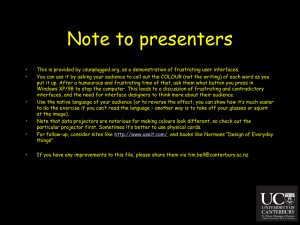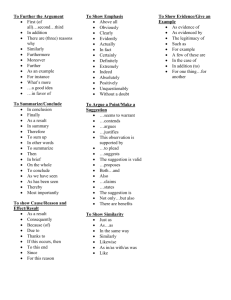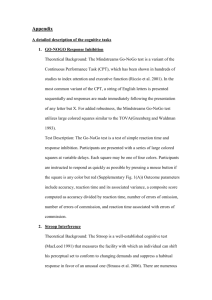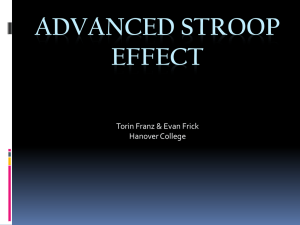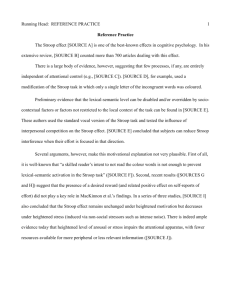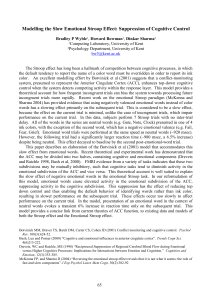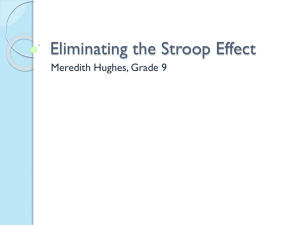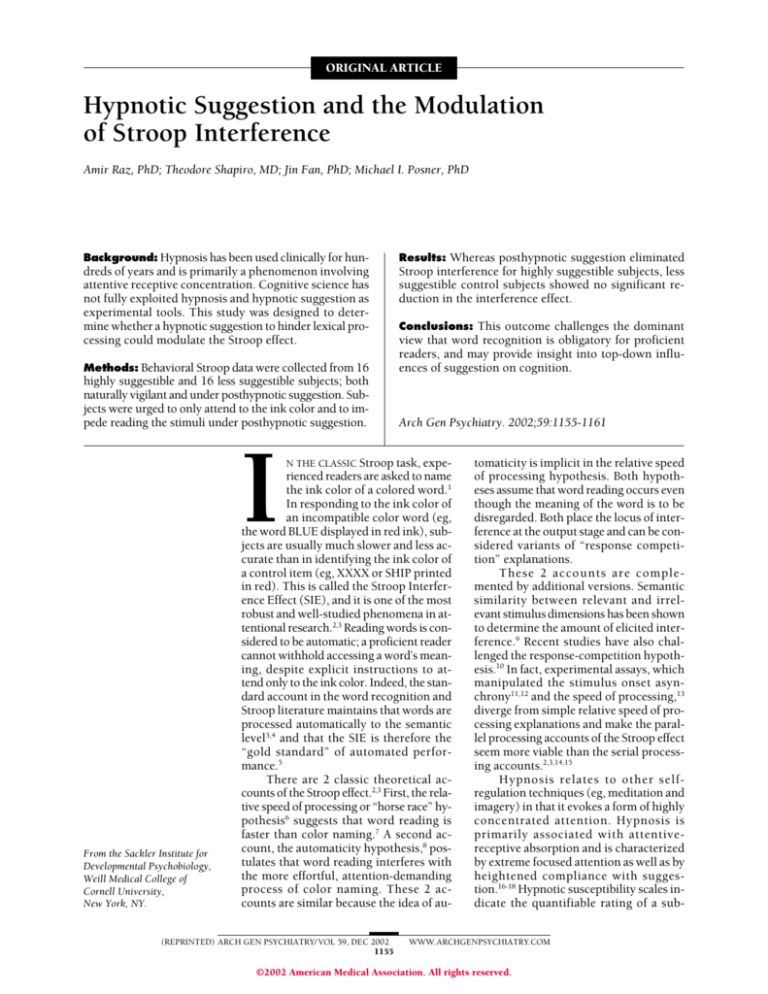
ORIGINAL ARTICLE
Hypnotic Suggestion and the Modulation
of Stroop Interference
Amir Raz, PhD; Theodore Shapiro, MD; Jin Fan, PhD; Michael I. Posner, PhD
Background: Hypnosis has been used clinically for hundreds of years and is primarily a phenomenon involving
attentive receptive concentration. Cognitive science has
not fully exploited hypnosis and hypnotic suggestion as
experimental tools. This study was designed to determine whether a hypnotic suggestion to hinder lexical processing could modulate the Stroop effect.
Methods: Behavioral Stroop data were collected from 16
highly suggestible and 16 less suggestible subjects; both
naturally vigilant and under posthypnotic suggestion. Subjects were urged to only attend to the ink color and to impede reading the stimuli under posthypnotic suggestion.
I
From the Sackler Institute for
Developmental Psychobiology,
Weill Medical College of
Cornell University,
New York, NY.
Results: Whereas posthypnotic suggestion eliminated
Stroop interference for highly suggestible subjects, less
suggestible control subjects showed no significant reduction in the interference effect.
Conclusions: This outcome challenges the dominant
view that word recognition is obligatory for proficient
readers, and may provide insight into top-down influences of suggestion on cognition.
Arch Gen Psychiatry. 2002;59:1155-1161
N THE CLASSIC Stroop task, expe-
rienced readers are asked to name
the ink color of a colored word.1
In responding to the ink color of
an incompatible color word (eg,
the word BLUE displayed in red ink), subjects are usually much slower and less accurate than in identifying the ink color of
a control item (eg, XXXX or SHIP printed
in red). This is called the Stroop Interference Effect (SIE), and it is one of the most
robust and well-studied phenomena in attentional research.2,3 Reading words is considered to be automatic; a proficient reader
cannot withhold accessing a word’s meaning, despite explicit instructions to attend only to the ink color. Indeed, the standard account in the word recognition and
Stroop literature maintains that words are
processed automatically to the semantic
level3,4 and that the SIE is therefore the
“gold standard” of automated performance.5
There are 2 classic theoretical accounts of the Stroop effect.2,3 First, the relative speed of processing or “horse race” hypothesis6 suggests that word reading is
faster than color naming.7 A second account, the automaticity hypothesis,8 postulates that word reading interferes with
the more effortful, attention-demanding
process of color naming. These 2 accounts are similar because the idea of au-
(REPRINTED) ARCH GEN PSYCHIATRY/ VOL 59, DEC 2002
1155
tomaticity is implicit in the relative speed
of processing hypothesis. Both hypotheses assume that word reading occurs even
though the meaning of the word is to be
disregarded. Both place the locus of interference at the output stage and can be considered variants of “response competition” explanations.
These 2 accounts are complemented by additional versions. Semantic
similarity between relevant and irrelevant stimulus dimensions has been shown
to determine the amount of elicited interference.9 Recent studies have also challenged the response-competition hypothesis.10 In fact, experimental assays, which
manipulated the stimulus onset asynchrony11,12 and the speed of processing,13
diverge from simple relative speed of processing explanations and make the parallel processing accounts of the Stroop effect
seem more viable than the serial processing accounts.2,3,14,15
Hypnosis relates to other selfregulation techniques (eg, meditation and
imagery) in that it evokes a form of highly
concentrated attention. Hypnosis is
primarily associated with attentivereceptive absorption and is characterized
by extreme focused attention as well as by
heightened compliance with suggestion.16-18 Hypnotic susceptibility scales indicate the quantifiable rating of a sub-
WWW.ARCHGENPSYCHIATRY.COM
©2002 American Medical Association. All rights reserved.
ject’s response to suggestions under standard conditions.
In the Stanford Hypnotic Susceptibility Scale Form C
(SHSS-C),19 one’s hypnotic suggestibility can be classified as either “high” or “low.” Some researchers prefer
to use hypnotic “suggestibility” over “hypnotizability,”20 but such terminological variations are often used
interchangeably. Whereas there are no substantial correlates of hypnotic suggestibility with personality measures,21 response expectancy does correlate reliably with
hypnotic suggestibility.22,23 Some clinicians practicing hypnosis suggest that when a highly suggestible person is
hypnotized, attentional and perceptual changes may occur that would not have occurred had one been commonly vigilant.24,25
The Stroop paradigm provides a promising way to
investigate the modulation of attentional networks and
top-down control via hypnosis and suggestion.18 Although neuroimaging data reported by Kosslyn et al26
show that a neural process as low-level as color perception was successfully affected by hypnotic suggestion,26
other recent data suggest that hypnotic instruction for
color blindness did not inhibit the SIE27 (note earlier attempts at hypnotic suggestions for color blindness,28-31
negative visual hallucination, and agnosia,32 or comparable efforts in the auditory modality33,34).
The current study is a “mirror image” of that by
Kosslyn et al,26 since in light of inconsistent data attempting to modulate the SIE through hypnotic manipulation
of color perception,27-31 we instead used a posthypnotic
suggestion, which directed subjects not to read meaningful words (see “Methods” section). Based on previous research with hypnosis, we expected the highly suggestible subjects to be compliant with the suggestion made
during the hypnotic experience following the hypnotic
session, but not to remember the instruction.
The Stroop effect is not new to the hypnosis literature. Blum and Graef35 first reported that under hypnosis (without suggestion), the SIE was bigger in highly suggestible as compared with less suggestible.35 Sheehan et
al also reported that the SIE was magnified under suggestion-free hypnosis.36 On the other hand, using suggestion outside of hypnosis, Sun37 found no difference
in the SIE between highly and less suggestible subjects,37 but Sheehan et al36 found a bigger SIE for the highly
suggestible. Thus, some highly suggestible individuals
seem to display increased SIE compared with less suggestible subjects under suggestion-free hypnosis. Furthermore, SIE was reduced when subjects were instructed to shift their gaze away from the displayed word
and to covertly attend to the bottom portion of the last
letter of the word to be ignored.36 Using a comparable
strategy, Sun found that the SIE was significantly reduced for the highly suggestible, but not for the less suggestible.37 Hence, hypnotic suggestions containing explicit attentional strategies seem to obviate the prepotent
inclination to read in the highly suggestible. Lastly, Dixon
and Laurence, extending their earlier study,38 looked at
highly vs less suggestible subjects outside of hypnosis
and explored the interaction between automatic and
controlled processing, using a “strategy free” modified
Stroop procedure.39 Both studies showed that when
strategic influences were minimized, a reliable differ(REPRINTED) ARCH GEN PSYCHIATRY/ VOL 59, DEC 2002
1156
ence between highly suggestible and less suggestible
subjects was apparent: the highly suggestible showed
larger Stroop effects than the less suggestible. In general, these findings proposed that outside of the hypnotic context, the highly suggestible subjects processed
words more automatically than the less suggestible.
In contrast to these studies of the SIE during hypnosis, the present study did not instruct subjects to follow a variation of a peripheral strategy such as looking
away or blurring vision. Rather, the goal of the present
study was to establish whether a simple strategy-free posthypnotic suggestion to circumvent reading could effectively modulate the SIE within a classical Stroop design.
Our aim was to determine whether it would be possible
to obviate the pervasiveness of word reading, using a subjective behavioral indicant and by recruiting hypnosis as
an attentional manipulation.18 Specifically, we hypothesized that if this instruction were effective, we would
no longer observe the relative advantage (ie, faster reaction time [RT] and higher accuracy) commonly associated with congruent trials. Furthermore, we speculated
that the specific suggestion would reduce or completely
remove the SIE for highly suggestible subjects, but have
no effect on the less suggestible.
METHODS
Subjects consisted of 32 proficient readers of English (mean
age, 24.3 years) naı̈ve to the Stroop task, who agreed to participate in this study in exchange for an average compensation
of $30 per hour. Subjects were recruited from a pool of 75 volunteers (mostly medical students at the Weill Medical College
of Cornell University, New York, NY) who had earlier been individually screened for suggestibility in a hypnotic context using the SHSS-C19 (absent the anosmia to ammonia challenge).
Sixteen hypnosis subjects (8 female, 8 male; 4 nonnative) scoring in the highly suggestible range (10-11 of a possible 11), and
16 control subjects (7 female, 9 male; 4 nonnative) scoring in
the less-suggestible range (2-3 of a possible 11) on the SHSS-C
were recruited for further participation.
MATERIALS
Subjects sat at a viewing distance of approximately 65 cm in
front of a color computer monitor. Stimuli consisted of a single
word written in one of 4 ink colors (red, blue, green, or yellow) appearing at the center of the computer screen, where a
black fixation cross was visible. All characters were displayed
in upper-case font against a white background, and the stimuli
subtended visual angles of 0.5° vertically, and 1.3° to 1.9° horizontally (depending on word length). Two classes of words
were used: color words (RED, BLUE, GREEN, and YELLOW)
and neutral words (LOT, SHIP, KNIFE, and FLOWER), with
the latter class being frequency-matched as well as lengthmatched to the color words.
Three experimental conditions were used: a congruent condition consisting of a color word inked in its own color; a neutral condition consisting of a neutral word inked in any one of
the 4 colors; and an incongruent condition consisting of a color
word inked in any of the 3 colors (eg, the color word BLUE inked
in green) other than the one to which it referred. During each
trial, subjects were asked to indicate the ink color in which a word
was written by depressing one of 4 keys on a keyboard. Although button pressing reduces effect size relative to vocal naming, we opted for it because of its relative merit in a sequel neuroimaging assay. The color-labeled response keys were “V,” “B,”
WWW.ARCHGENPSYCHIATRY.COM
©2002 American Medical Association. All rights reserved.
Table 1. Mean Reaction Times and Error*
Congruent
Group
Highly suggestible subjects (n = 16)
Less suggestible subjects (n = 16)
Neutral
Incongruent
Posthypnotic Suggestion
RT, ms
Error, %
RT, ms
Error, %
RT, ms
Error, %
Absent
Present
Absent
Present
703
664
694
687
2
2
3
3
748
671
719
721
2
2
4
6
860
669
798
808
6
2
6
7
*RT indicates reaction time.
“N,” and “M” for the colors red, blue, green, and yellow, respectively. Two fingers of each hand were used to press these response keys (ie, left middle finger for V, right index finger for N,
etc). Speed and accuracy were emphasized equally.
DESIGN AND PROCEDURE
The experimental design was a mixed factorial model with
“group” (highly or less suggestible) and “order” (naturally
alert→posthypnotized, posthypnotized→naturally alert) as between-subject factors, and with “posthypnotic-suggestion” (absent, present) and “congruency” (congruent, neutral, incongruent) as within-subject factors. Following a standard Stanford
induction,19 posthypnotic suggestion was a within-subject factor in the sense that all subjects participated in both a naturally alert (N) and a posthypnotized (PH) condition. No suggestion was made under N; posthypnotic suggestion was made
under PH. Administration order (N→PH vs PH→N) was counterbalanced across groups.
Informed consent was obtained from all subjects in advance in the following manner: preceding the experiment, an
experimenter notified the subjects that the purpose of the study
was to investigate the effects of suggestion on cognitive performance. Subjects were told that hypnotic inductions and suggestions would be administered at certain points during the experiment and that they would be asked to play a computer game
(ie, Stroop) with the experimenter present in the room.
Subjects were instructed to focus their eyes on a fixation cross
at the center of the screen. A stimulus would then appear on the
screen replacing the crosshair. The stimulus remained on the screen
for a maximum of 2 seconds or until subjects responded. Following a response, veridical visual feedback was provided (ie,
“CORRECT” or “INCORRECT” was flashed in black ink), and
the fixation cross was redisplayed at the center for a variable duration contingent on the subject’s RT. At this point, a new stimulus appeared on the screen, again replacing the fixation cross and
beginning the next trial. The interstimulus interval was always 4
seconds (preparing for a follow-up neuroimaging design).
Thirty-two practice trials preceded the first session for each
subject. This training session was used to confirm that subjects were able to understand the task, proficiently map the 4
colors to the appropriate response keys, and respond quickly
and accurately. Following this brief training session, subjects
took a short break and then completed 144 experimental trials. One-third of all trials were neutral, congruent, and incongruent, respectively. Trial order was randomized throughout
the experiment.
The following posthypnotic suggestion was verbally presented to both highly suggestible and less-suggestible subjects
subsequent to a standard hypnotic induction:19
Very soon you will be playing the computer game. When
I clap my hands, meaningless symbols will appear in the
middle of the screen. They will feel like characters of a
foreign language that you do not know, and you will not
(REPRINTED) ARCH GEN PSYCHIATRY/ VOL 59, DEC 2002
1157
attempt to attribute any meaning to them. This gibberish will be printed in one of 4 ink colors: red, blue, green
or yellow. Although you will only be able to attend to
the symbols’ ink color, you will look straight at the
scrambled signs and crisply see all of them. Your job is
to quickly and accurately depress the key that corresponds to the ink color shown. You will find that you
can play this game easily and effortlessly.
The specific wording of this suggestion is significant because the particular phrasing was the result of a tedious piloting process of trial and repetition. Initially, we attempted to use
variations on less specific instructions, telling highly suggestible subjects that they would see letters and not know that they
formed meaningful words. This approach was not consistently successful, but introducing the concept of an unfamiliar foreign language seemed plausible to the subjects.
Subjects were randomly assigned to an administration order of the 2 experimental conditions. Half of the subjects in
each group (ie, highly or less suggestible) were first run on the
Stroop task following hypnosis induction with the previously
mentioned posthypnotic suggestion and then (after a 15minute break) when naturally alert in a common Stroop context. The remaining subjects experienced these 2 conditions
in the reverse order. When not under the posthypnotic suggestion condition, subjects were simply instructed to foveate
on the center fixation cross and respond (ie, depress the appropriate keys) as quickly and as accurately as possible in response to the ink color of the stimuli.
Interviews free of any hypnotic influence were conducted (and videotaped) immediately following the posthypnotic-suggestion sessions, when subjects regained their natural (nonhypnotic) attentiveness.
RESULTS
Table 1 presents the mean RT and mean error scores
for the 2 attentional conditions (ie, naturally alert vs
posthypnotized) as a function of the 3 Stroop conditions
(ie, congruent, neutral, and incongruent) for the 2 subject groups. Incorrect responses were excluded from the
analyses, as were RTs that were 3 SDs either above or
below the mean. Approximately 1.5% of all the data
were excluded owing to deviant RTs for both the highly
suggestible and less-suggestible subjects, respectively.
Table 2 presents subtractions of the various data
from Table 1 to indicate the overall SIE (I-C) as well as
the breakdown into interference (I-N) and facilitation
(N-C).
Table 3 summarizes the analysis of variance analyses of the data from Table 2, separately displaying RT and
errors.
WWW.ARCHGENPSYCHIATRY.COM
©2002 American Medical Association. All rights reserved.
Table 2. Performance of the Stroop Congruency Subtractions*
I-C
Group
I-N
N-C
Posthypnotic
Suggestion
Interference + Facilitation
Error
Interference
Error
Facilitation
Error
Absent
Present
Absent
Present
157
5
104
121
4
0
3
4
112
−2
79
87
4
0
2
1
45
7
25
34
0
0
1
3
Highly suggestible subjects (n = 16)
Less suggestible subjects (n = 16)
*Interference and/or facilitation values are in mean milliseconds; error values are percentages. I-C indicates incongruent-congruent; I-N, incongruent-neutral;
and N-C, neutral-congruent.
Table 3. Analysis of Variance Main Effects and Interactions*
RT
Effect
Order
Group
Suggestion
Order ⫻ Group
Order ⫻ Suggestion
Group ⫻ Suggestion
Order ⫻ Group ⫻
Suggestion
Error
(I-C)
(I-N)
(N-C)
(I-C)
(I-N)
(N-C)
F⬍1
F1,28 = 1.67, P = .206
F1,28 = 10.80, P⬍.005
F⬍1
F⬍1
F1,28 = 17.13, P⬍.001
F⬍1
F⬍1
F1,28 = 1.47, P = .235
F1,28 = 6.84, P⬍.05
F⬍1
F⬍1
F1,28 = 9.36, P⬍.01
F⬍1
F1,28 = 6.42, P⬍.05
F⬍1
F1,28 = 2.36, P = .136
F⬍1
F⬍1
F1,28 = 5.91, P⬍.05
F⬍1
F⬍1
F1,28 = 2.51, P = .124
F1,28 = 3.72, P = .064
F⬍1
F⬍1
F1,28 = 5.56, P⬍.05
F1,28 = 1.84, P = .185
F1,28 = 2.38, P = .134
F⬍1
F1,28 = 12.32, P⬍.005
F⬍1
F⬍1
F1,28 = 1.37, P = .252
F⬍1
F1,28 = 1.46, P = .237
F1,28 = 4.05, P = .054
F1,28 = 2.09, P = .159
F⬍1
F⬍1
F1,28 = 2.09, P = .159
F⬍1
*Effects and interactions apply to the data in Table 2 under the experimental design. Statistically significant effects (ie, P⬍.05) appear in bold. RT indicates reaction
time; I-C, incongruent-congruent; I-N, incongruent-neutral; and N-C, neutral-congruent.
RT ANALYSIS
Inspection of the main effects showed that posthypnotic suggestion caused a significant reduction in Stroop
interference. (Note that the significant order main effect
for Stroop facilitation has no interactions associated with
it and constitutes a practice effect not related to posthypnotic suggestion.)
Since our hypotheses had been laid out before the
experiment, planned comparisons were performed to further investigate the results. Considered with the data from
Tables 2 and 3, these comparisons showed that whereas
the SIE differential was highly significant when contrasting the highly suggestible subjects between the 2 hypnoticsuggestion conditions (F1,30 = 29.35, P⬍.001) for I-C
F1,30 =16.78, P⬍.001) for I-N), it was not significant for
the less-suggestible group (F⬍1 for both). Additionally, in the absence of hypnotic suggestion there was no
significant SIE difference between highly suggestible and
less suggestible subjects (F1,30 =2.09, P=.16 for I-C; F⬍1
for I-N), but in the presence of hypnotic suggestion, a
significant effect was found (F1,30 =21.20, P⬍.001 for I-C;
F1,30 =16.66, P⬍.001 for I-N).
Tests of the RTs (Table 2) under posthypnotic suggestion in the highly suggestible group revealed that neither was significantly different from zero (F⬍1), indicating that interference and facilitation were completely
removed by the posthypnotic suggestion.
ERROR ANALYSIS
Table 3 indicates how posthypnotic suggestion significantly reduced interference errors. Planned compari(REPRINTED) ARCH GEN PSYCHIATRY/ VOL 59, DEC 2002
1158
sons showed that the performance differential was significant for the high-suggestible group between the
suggestion conditions for interference (F1,30 = 11.50,
P =.002). Conversely, the less suggestible did not differ
significantly on error performance as a function of suggestion for interference (F1,30 =2.88, P=.10). In the absence of posthypnotic suggestion, the performance difference between the 2 groups was not significant for
interference (F⬍1) as was the case in the presence of the
posthypnotic suggestion (F1,30 =1.40, P=.24).
Postexperimental interviews showed that 12 highly
suggestible subjects reported having seen only “colored
images,” “scrambled symbols,” “gibberish,” or “words
in an unknown foreign language” on the computer
screen. The remaining 4 highly suggestible subjects
reported awareness that words were sometimes flashed
on the screen, but that they could ignore reading them
most of the time. Conversely, all control (less suggestible) subjects reported being cognizant of the word
stimuli.
COMMENT
This article follows our effort to relate hypnosis to cognitive studies of attention.18 Interference in the stroop
effect has been considered a prime case of attentional control in processing sensory input. The data indicate that,
for some subjects, the SIE can be removed, and performance significantly enhanced by means of an attentional manipulation (hypnosis) accompanied by a specific posthypnotic suggestion to thwart reading.
Specifically, the reported data show that hypnosis plus
a carefully crafted suggestion (containing no reference
WWW.ARCHGENPSYCHIATRY.COM
©2002 American Medical Association. All rights reserved.
to a specific attentional strategy) can obviate the effect
of automatic word reading and suffice to eliminate the
SIE in operationally defined highly suggestible proficient English readers.
Experimental order (ie, whether subjects were first
tested under posthypnotic suggestion or while naturally alert) did not significantly affect the experimental
outcome. Analysis of the RT data showed that whereas
responses were both collectively faster and comparable
across the 3 Stroop conditions under posthypnotic suggestion for the highly suggestible (consistent with our
hypothesis that lexical processing was impeded), this trend
was not elicited from the less suggestible (see Table 1).
Interestingly, nullifying the “relative advantage” (ie, faster
RT and higher accuracy) of the congruent trials as a function of posthypnotic suggestion was also consistent with
error performance. As expected, not only was the traditional SIE present for the less suggestible within the posthypnotic suggestion condition, it was not significantly
different from the RT trend acquired while naturally alert.
Performance analysis further showed that the highly suggestible made significantly fewer interference errors under posthypnotic suggestion. Similarly, although facilitation (N-C) is not always evident in color Stroop
paradigms in which manual responses are used,40 the
present results show that as a consequence of the posthypnotic suggestion, not only was the SIE removed in
the highly suggestible, but so was facilitation. Although
performance accuracy was increased on all conditions under posthypnotic suggestion, only for the incongruent
trials was a significant difference obtained. These results might hold important implications for neurocognitive investigations of the interaction between attentional resources and word recognition. Evidently, the
involvement of attention in word reading warrants closer
scrutiny.
Not only is attention known to modulate the
activity of evoked visual stimuli within early brain
areas,41 recent functional imaging data indicate that
attention can strikingly influence word reading as
well. Rees et al42 reported inattentional blindness (ie,
utter failure to perceive words) even for highly familiar and meaningful stimuli when looked at directly at
the center of gaze. By creating a situation in which
subjects could look straight at a word without attending to it, Rees et al showed that brain activity in
response to recognizable visual words vs random letters entirely depended on attention. Since hypnosis is
likely to propel an attentional gradient, taken together
with the present data, these findings seem to suggest
that word reading was effectively prevented under the
posthypnotic-suggestion condition.
In one parallel distributed processing model, Cohen et al15 suggested a connectionist account of the Stroop
effect using spreading activation along pathways of different strengths. A particularly attractive feature of this
early model is that attention is realized as the modulation of the operation of processing units along a pathway, thus making attention inherent to the model, and
not an external element applied to it. Indeed, attention
may play a pivotal role in modulating the ballistic nature of word reading.
(REPRINTED) ARCH GEN PSYCHIATRY/ VOL 59, DEC 2002
1159
REDUCING AND REMOVING THE STROOP
INTERFERENCE EFFECT
The traditional SIE is understood to indicate that one cannot screen perfectly for only what is relevant, and that
concurrent processing of irrelevant information takes place
even if this is unfavorable to the task at hand. Because
the SIE is a vigorous attentional phenomenon and is difficult to reduce by practice, there is widespread accord
in the Stroop literature that skilled readers obligatorily
process printed stimuli presented to the fovea. Nonetheless, complementing the present results, recent reports
have shown that within particular (hypnosis-free) contexts, the SIE can also be significantly reduced or eliminated.43-54 Although critiqued on multiple aspects,55-57 these
reports suggest that a seemingly unconsciously controlled process can be derailed by relatively simple means.
Such results put forth a challenge to the commonly accepted construct of automatic, involuntary activation of
word representations, and suggest that these processes
are perhaps malleable to the point of elimination. Indeed, current theories of the SIE are incompatible with
such findings.
There is little disagreement that the role of attentional strategies58,59 and mental set60 is to serve as determinants in SIE elicitation. Additionally, it is well known
that diverting gaze away from the stimuli, blurring vision, concentrating on a single letter within a word stimulus, speeding or slowing of response, and employing a
particular congruent to incongruent trial ratio can all significantly affect the SIE.
POTENTIAL STRATEGIES
Sheehan et al36 found the SIE to be increased in the highly
suggestible under hypnosis unless special instructions
were given to overcome the effect. In light of these data
and the literature examining the effects of various strategies on the SIE, it may be that the hypnotized subjects
still instigated some strategy while performing the present experimental task, even without instructions. During the postexperimental interviews, subjects reported
that they had indeed observed all symbols within a stimulus and universally denied use of alternative strategies.
Whereas the experimental instructions explicitly directed subjects to “look straight at” and “crisply see” all
the symbols comprising the stimuli shown at the center
of the screen, recruitment of covert strategies cannot be
easily ruled out (ie, it is perhaps plausible that hypnotic
subjects may be successful in deceiving themselves).
Attempting to reconstruct strategies that may have
been covertly used by the subjects, 2 are most likely: focusing visual gaze away from the central target, and blurring of vision. The effects of changes in the distribution
of spatial attention have largely been neglected in the
Stroop literature; nonetheless, some reports strongly
suggest that spatial attention may play a critical role in
visual word recognition.61 Besner and Stolz46 reported
that the SIE can be reduced in magnitude or removed
when a single letter position in a colored word is precued (hence the importance that all letters are seen
crisply as part of the posthypnotic suggestion). VideoWWW.ARCHGENPSYCHIATRY.COM
©2002 American Medical Association. All rights reserved.
taped recordings of the experimental sessions showed
subjects unmistakably focusing on the central target.
Furthermore, blurry vision is unlikely because subjects
were unambiguously instructed to sharply see the
stimuli. On ophthalmological grounds, it is theoretically possible to maintain either a spasm of accommodation or a relaxation of accommodation (ie, volitionally have the image fall either in front of or behind the
retinae) for the duration of the experiment, but the intermittent presentation of the stimuli and fixation point
makes this option improbable. An online technique (eg,
ultrasound) to monitor the convexity of the lens can be
used to determine this issue, but such technology is
currently in a nascent stage.
We conclude that posthypnotic suggestion markedly reduces Stroop interference for the highly suggestible subjects as compared with controls, indicating that
posthypnotic suggestion, when effective, must operate
through a top-down mechanism that modifies the processing of input words through a means not voluntarily
available. This outcome challenges the dominant view that
word recognition is obligatory for all proficient readers and
may allow insight into the top-down influences exerted
by suggestion. Because it has been reported that highly suggestible people can respond to suggestions even without
hypnosis,20,62 it is not clear whether a hypnotic context is
essential to the effect achieved. An appropriate study is currently underway to explore this question.
Finally, a related result using neuroimaging indicated that the hypnotic instruction not to see color prevented activation of prestriate areas related to processing color.26 The processing of printed words involves areas
of the prestriate visual system (visual word form), the temporoparietal junction (phonology), and prefrontal and
posterior areas related to semantics. We already have initiated several imaging studies to find out where the instruction not to see the stimulus as a meaningful word
influences this stream of information processing.
Submitted for publication November 2, 2001; final revision
received January 25, 2002; accepted March 6, 2002.
Financial support was provided by the DeWitt WallaceReader’s Digest Research Fellowship in Psychiatry (Dr Raz).
We thank Irving Kirsch, PhD, Colin M. MacLeod, PhD,
Derek Besner, PhD, Heidi E. Sormaz, PhD, Gerald P. Marinoff, MD, Julius Kuhl, PhD, Miguel Kazén, PhD, Herbert
Spiegel, MD, David Spiegel, MD, Bruce D. McCandliss, PhD,
and Jessica M. Pollard, BA, for constructive comments on
this article.
Corresponding author and reprints: Amir Raz, PhD,
Sackler Institute for Developmental Psychobiology, Department of Psychiatry, Weill Medical College of Cornell University, 1300 York Ave, Box 140, New York, NY 10021
(e-mail: amr2006@med.cornell.edu).
REFERENCES
1. Stroop JR. Studies of interference in serial verbal reactions. J Exp Psychol. 1935;
18:643-661.
2. MacLeod CM, MacDonald PA. Interdimensional interference in the Stroop effect:
uncovering the cognitive and neural anatomy of attention. Trends Cogn Sci. 2000;
4:383-391.
(REPRINTED) ARCH GEN PSYCHIATRY/ VOL 59, DEC 2002
1160
3. MacLeod CM. Half a century of research on the Stroop effect: an integrative review. Psychol Bull. 1991;109:163-203.
4. Neely JH. Semantic priming effects in visual word recognition: a selective review of current findings and theories. In: Besner D, Humphreys GW, eds. Basic
Processes in Reading: Visual Word Recognition. Hillsdale, NJ: Erlbaum; 1991:
264-336.
5. MacLeod CM. The Stroop task: the “gold standard” of attentional measures.
J Exp Psychol Gen. 1992;121:12-14.
6. Posner MI, Snyder CRR. Attention and cognitive control. In: Solso RL, ed. Information Processing and Cognition: The Loyola Symposium. Hillsdale, NJ:
Erlbaum; 1975:55-85.
7. Theios J, Amrhein PC. Theoretical analysis of the cognitive processing of lexical
and pictorial stimuli: reading, naming, and visual and conceptual comparisons.
Psychol Rev. 1989;96:5-24.
8. LaBerge D, Samuels SJ. Toward a theory of automatic information processing
in reading. Cognit Psychol. 1974;6:293-323.
9. Klopfer DS. Stroop interference and color-word similarity. Psychol Sci. 1996;7:
150-157.
10. Luo CR. Semantic competition as the basis of Stroop interference: evidence from
color-word matching tasks. Psychol Sci. 1999;10:35-40.
11. Glaser MO, Glaser WR. Time course analysis of the Stroop phenomenon. J Exp
Psychol Hum Percept Perform. 1982;8:875-894.
12. Glaser WR, Dungelhoff FJ. The time course of picture-word interference. J Exp
Psychol Hum Percept Perform. 1984;10:640-654.
13. Dunbar KN, MacLeod CM. A horse race of a difference color: Stroop interference patterns with transformed words. J Exp Psychol Hum Percept Perform. 1984;
10:622-639.
14. Phaf RH, Van der Heijden AH, Hudson PT. SLAM: a connectionist model for attention in visual selection tasks. Cognit Psychol. 1990;22:273-341.
15. Cohen JD, Dunbar K, McClelland JL. On the control of automatic processes: a
parallel distributed processing model of the Stroop effect. Psychol Rev. 1990;
97:332-361.
16. Hilgard ER. Hypnotic Susceptibility. New York, NY: Harcourt, Brace & World; 1965.
17. Spiegel H, Spiegel D. Trance and Treatment: Clinical Uses of Hypnosis. Washington, DC: American Psychiatric Press; 1987.
18. Raz A, Shapiro T. Hypnosis and neuroscience: a cross talk between clinical and
cognitive research. Arch Gen Psychiatry. 2001;59:85-90.
19. Weitzenhoffer AM, Hilgard ER. Stanford Hypnotic Susceptibility Scale: Form C.
Palo Alto, Calif: Consulting Psychologists Press; 1962.
20. Kirsch I, Braffman W. Imaginative suggestibility and hypnotizability. Curr Dir Psychol Sci. 2001;10:57-61.
21. Nash MR. The truth and the hype of hypnosis. Sci Am. 2001;285:46-49,52-55.
22. Braffman W, Kirsch I. Imaginative suggestibility and hypnotizability: an empirical analysis. J Pers Soc Psychol. 1999;77:578-587.
23. Kirsch I, Silva CE, Comey G, Reed S. A spectral analysis of cognitive and personality variables in hypnosis: empirical disconfirmation of the two-factor model
of hypnotic responding. J Pers Soc Psychol. 1995;69:167-175.
24. Spiegel D, Cutcomb S, Ren C, Pibram K. Hypnotic hallucination alters evoked
potentials. J Abnorm Psychol. 1985;94:249-255.
25. Spiegel D, Bierre P, Rootenberg J. Hypnotic alteration of somatosensory perception. Am J Psychiatry. 1989;146:749-754.
26. Kosslyn SM, Thompson WL, Costantini-Ferrando MF, Alpert NM, Spiegel D. Hypnotic visual illusion alters brain color processing. Am J Psychiatry. 2000;157:
1279-1284.
27. Mallard D, Bryant RA. Hypnotic color blindness and the Stroop test. Int J Clin
Exp Hypn. 2001;49:330-338.
28. Harvey MA, Sipprelle CN. Color blindness, perceptual interference, and hypnosis. Am J Clin Hypn. 1978;20:189-193.
29. Erickson MH. The induction of color blindness by a technique of hypnotic suggestion. J Gen Psychol. 1939;20:61-89.
30. Grether WF. A comment on “The Induction of Color Blindness by a Technique of
Hypnotic Suggestion.” J Gen Psychol. 1940;23:207-210.
31. Harriman PL. Hypnotic induction of color vision anomalies, I: the use of the Ishihara and the Jensen tests to verify the acceptance of suggested color blindness.
J Gen Psychol. 1942;26:289-298.
32. Blum GS, Wiess F. Attenuation of symbol/word interference by posthypnotic negative hallucination and agnosia. Exp Klin Hypn. 1986:2:58-62.
33. Szechtman H, Woody E, Bowers KS, Nahmias C. Where the imaginal appears
real: a positron emission tomography study of auditory hallucinations. Proc Natl
Acad Sci USA. 1998;95:1956-1960.
34. Dierks T, Linden DE, Jandl M, Formisano E, Goebel R, Lanfermann H, Singer W.
Activation of Heschl’s gyrus during auditory hallucinations. Neuron. 1999;22:
615-621.
35. Blum GS, Graef JR. The detection over time of subjects simulating hypnosis. Int
J Clin Exp Hypn. 1971;19:211-224.
WWW.ARCHGENPSYCHIATRY.COM
©2002 American Medical Association. All rights reserved.
36. Sheenan PW, Donovan P, MacLeod CM. Startegy manipulation and the Stroop
effect in hypnosis. J Abnorm Psychol. 1988;94:249-255.
37. Sun S. A comparative study of Stroop effect under hypnosis and in the normal
waking state [in Chinese]. Psychol Sci. 1994;17:287-290.
38. Dixon M, Brunet A, Laurence JR. Hypnotic susceptibility and verbal automatic
and strategic processing differences in the Stroop color-naming task. J Abnorm
Psychol. 1990;99:336-343.
39. Dixon M, Laurence JR. Hypnotic susceptibility and verbal automaticity: automatic and strategic processing differences in the stroop color-naming task.
J Abnorm Psychol. 1992;101:344-347.
40. Keele SW. Attention demands of memory retrieval. J Exp Psychol. 1972;93:245248.
41. Martı́nez A, Anllo-Vento L, Sereno MI, Frank LR, Buxton RB, Dubowitz DJ, Wong
EC, Hinrichs H, Heinze HJ, Hillyard SA. Involvement of striate and extrastriate
cortical areas in spatial selective attention: combined evidence from fMRI and
event-related potentials. Nat Neurosci. 1999;2:364-369.
42. Rees G, Russell C, Frith CD, Driver J. Inattentional blindness versus inattentional amnesia for fixated but ignored words. Science. 1999;286:2504-2507.
43. Kuhl J, Kazén M. Volitional facilitation of difficult intentions: joint activation of
intention memory and positive affect removes stroop interference. J Exp Psychol Gen. 1999;128;382-399.
44. De Jong R, Berendsen E, Cools R. Goal neglect and inhibitory limitations: dissociable causes of interference effects in conflict situations. Acta Psychol (Amst).
1999;101:379-394.
45. Besner D, Stolz JA, Boutilier C. The Stroop effect and the myth of automaticity.
Psychon Bull Rev. 1997;4:221-225.
46. Besner D. Stolz JA. What kind of attention modulates the Stroop effect? Psychon Bull Rev. 1999;6:99-104.
47. Melara RD, Algom D. A tectonic theory of Stroop effects. Psychol Rev. In press.
48. Besner D, Stolz JA. Unconsciously controlled processing: the Stroop effect reconsidered. Psychon Bull Rev. 1999;6:449-455.
49. Besner D. Stolz JA. Context dependency in Stroop’s Paradigm: when are words
treated as nonlinguistic objects? Can J Exp Psychol. 1999;53:374-380.
(REPRINTED) ARCH GEN PSYCHIATRY/ VOL 59, DEC 2002
1161
50. Besner D. The myth of ballistic processing: Evidence from Stroop’s paradigm.
Psychon Bull Rev. 2001;8:324-330.
51. Dishon-Berkovits M, Algom D. The Stroop effect: it is not the robust phenomenon that you have thought it to be. Mem Cognit. 2000;28:1437-1449.
52. Pansky A, Algom D. Stroop and Garner effects in comparative judgment of numerals: the role of attention. J Exp Psychol Hum Percept Perform. 1999:25:39-58.
53. Vivas AB, Fuentes LJ. Stroop interference is affected in inhibition of return. Psychon Bull Rev. 2001;8:315-323.
54. Arieh Y, Algom D. Processing picture-word stimuli: the contingent nature of picture and of word superiority. J Exp Psychol Learn Mem Cogn. 2002;28:221232.
55. MacLeod CM. Putting automaticity in context: reducing the Stroop effect. Paper
presented at: Joint Meeting of the Experimental Psychology Society and Canadian Society for Brain, Behaviour, and Cognitive Science; July 22, 2000; Cambridge, England.
56. Marmurek H. Response modality modulates single-letter effects in color-word
interference. Poster presented at: 40th Annual Meeting of the Psychonomic Society; November 18-21, 1999; Los Angeles, Calif.
57. Neely JH, Kahan T. Is semantic activation automatic? a critical re-evaluation. In:
Roediger HL, Nairne JS, Neath I, Surprenant AM, eds. The Nature of Remembering: Essays in Honor of Robert G. Crowder. Washington, DC: American Psychological Association; 2000.
58. Cheesman J, Merikle PM. Word recognition and consciousness. In: Besner D,
Waller TG, McKinnon E, eds. Reading Research: Advances in Theory and Practice. San Diego, Calif: Academic Press; 1985:311-352.
59. Logan GD, Zbrodoff NJ, Williamson J. Strategies in the color-word Stroop task.
Bull Psychon Soc. 1984;22:135-138.
60. Bauer B, Besner D. Mental set as a determinant of processing in the Stroop task.
Can J Exp Psychol. 1997;51:61-68.
61. Kahneman D, Henik A. Perceptual organization and attention. In: Kubovy M, Pomerantz JR, eds. Perceptual Organization. Hillsdale, NJ: Erlbaum; 1981:181-211.
62. Braffman W, Kirsch I. Imaginative suggestibility and hypnotizability: an empirical analysis. J Pers Soc Psychol. 1999;77:578-587.
WWW.ARCHGENPSYCHIATRY.COM
©2002 American Medical Association. All rights reserved.

